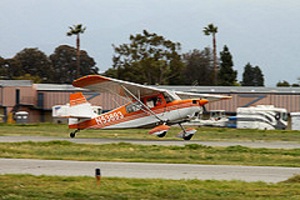Taildragger Crosswind Landings
The 3 Point or Full Stall Landing - Part 1
More...
Firstly some basic understanding of a Taildragger’s nature is required.
In a Nose Wheel aircraft the C of G is forward of the main wheels. A Nose Wheel aircraft is consequently directionally stable on the ground during take off and landing. During landing after the main wheels touch, the tendency is for the aircraft to lower the nose and reduce the angle of attack therefore keeping the plane on the ground.
In a Taildragger the C of G is behind the main wheels which means that on the ground it is inherently unstable directionally as the tail wants to overtake the nose. Once a directional swing starts it will continue unless arrested. Also in landing, if the aircraft is flown onto the main wheels, due to the C of G being rearward the the aircraft will increase the angle of attack and bounce/fly off again. If the aircraft is fully stalled for the landing it should touch all 3 wheels together.
There are two distinct landing techniques with Taildraggers. The first is the 3 point or full stall landing which I would use in normal conditions. Here in a crosswind landing the initial approach is crabbed until just prior to rounding out. As before we do crosswind management here which entails independently using rudder to point straight and simultaneously opposite airleron to control groundtrack. Now we roundout and as the speed decays we hold off. We are trying to NOT LAND the plane. We keep flying along in ground effect doing our crosswind management until the stick is fully back and we stall on. If we let the plane touch before full stall the mains will touch and due to the C of G being the mains the nose will pitch up and we will fly off for our first bounce (that's the small one, they only get bigger). Once the plane has fully stalled with the stick fully back against the stop and settles on the ground you immediately go FULL into wind aileron. The stick is already into wind to some degree but it now must go ALL the way. The stick stays full back and fully into wind. The purpose is two fold. Any lift being created is tending to keep the into wind wing down and aileron drag is helping you balance out the weather cocking force you are exposed to. This is where you are likely to lose it and improper use of the controls will cause your taildragger to take you for an unplanned ride. Now once landed FEET! FEET! FEET! Your dancing shoes are on. Remember it isn't over until the aircraft is parked in the hanger.......
Any comments or feedback appreciated. Part 2 will deal with the Wheeler Crosswind Landing. Till then Safe Flying and ENJOY.......



